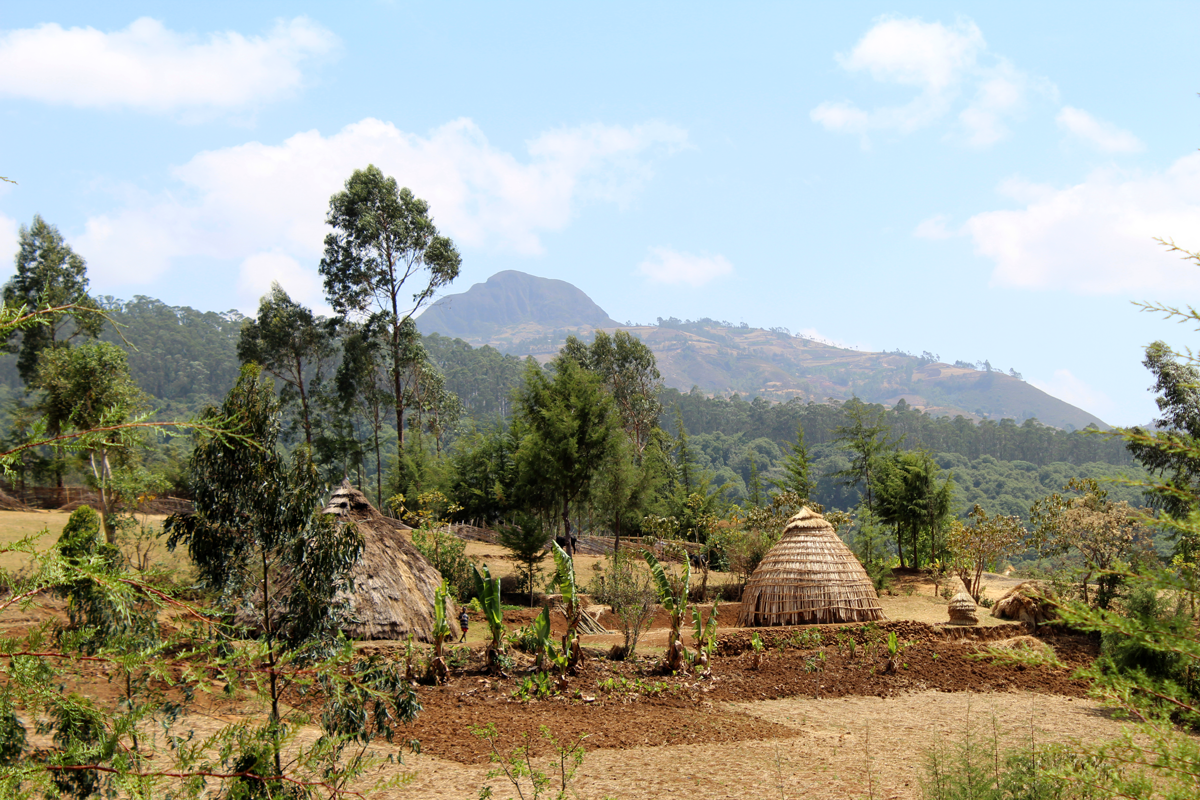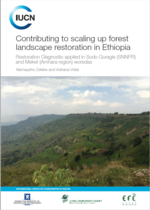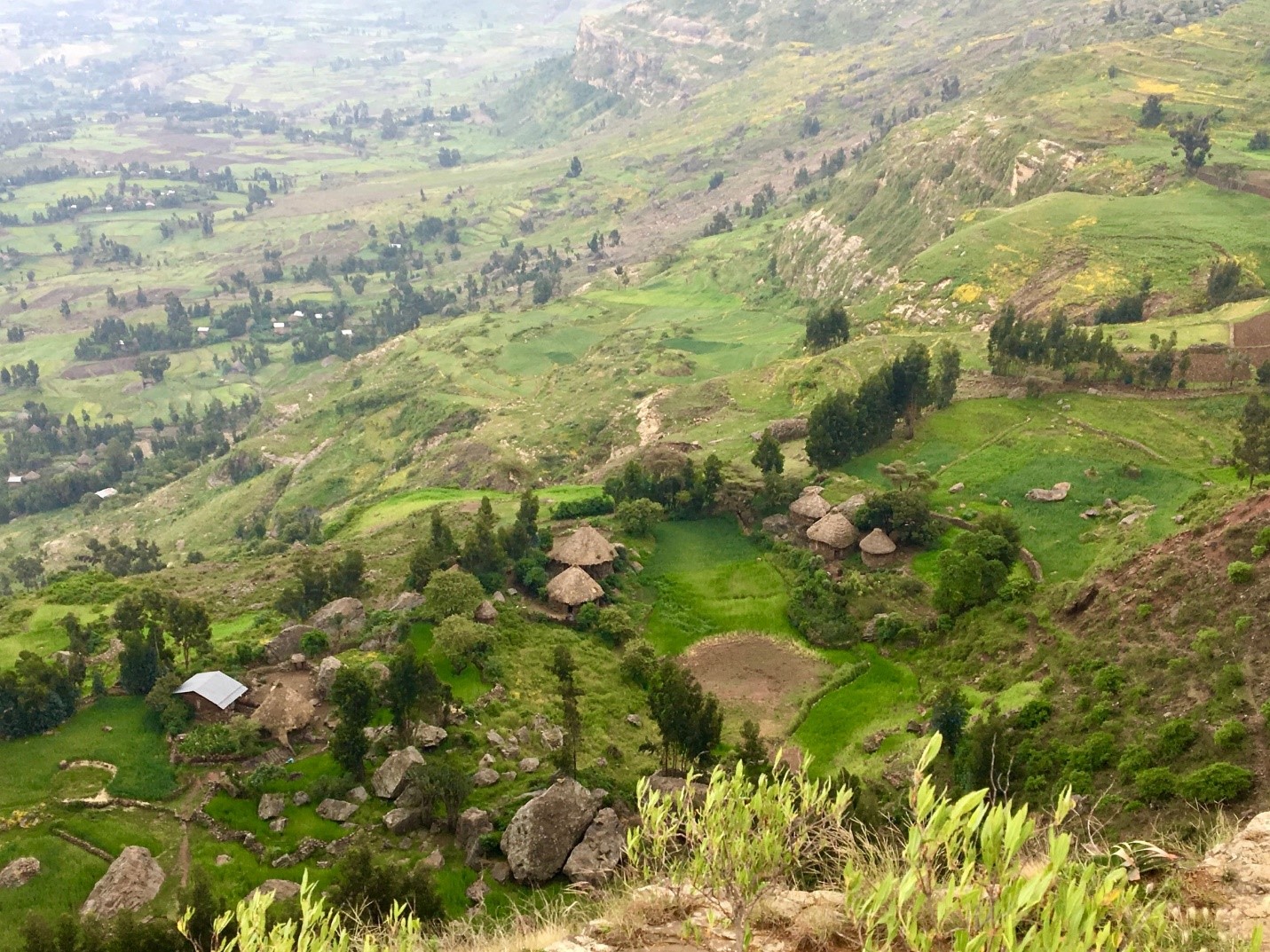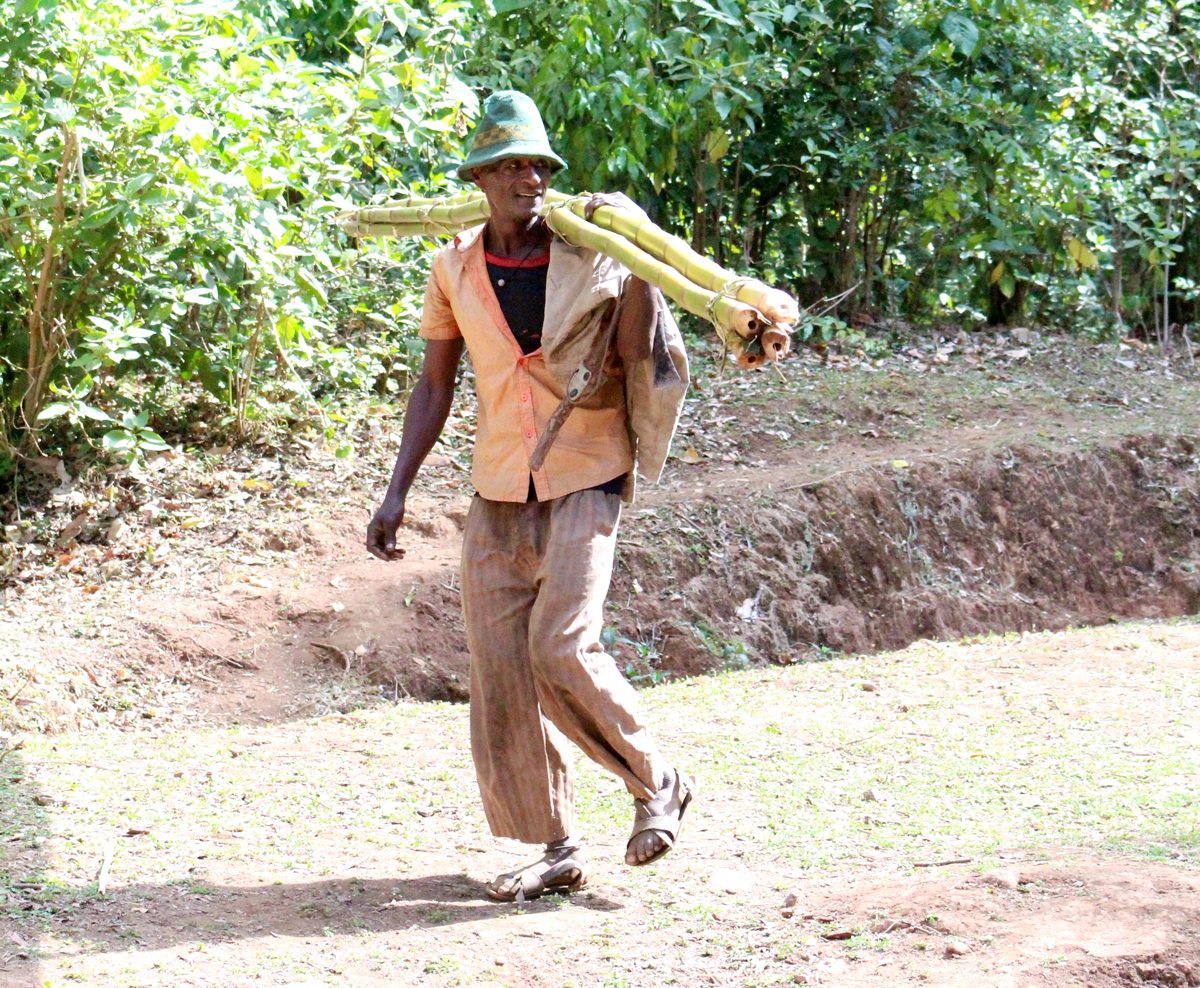Ethiopian landscape restoration in 3 steps: Motivate, enable and implement
Abridged lessons from a recent restoration diagnostic in two woredas in Ethiopia.

Photo: IUCN / Craig Beatty
Ethiopia is the second-most populous country in Africa. The economy is heavily dependent on agriculture with rain-fed, smallholder farming representing more than 90% of national agricultural outputs. This sector is also a major driver of forest and land degradation – the pressure to increase crop production has resulted in the expansion of agricultural lands and overgrazing. When combined with rapid population growth and associated fuelwood needs, recurrent droughts and entrenched poverty, the pressure on Ethiopia’s natural resources is immense
 Photo: IUCN / Craig Beatty
Photo: IUCN / Craig Beatty
Policies, strategies, proclamations, programmes, and plans have been developed since the 1990s to safeguard the country’s forest and to directly or indirectly address the conservation and development of forest resources and landscape restoration interventions. It’s estimated that 73% of Ethiopia’s land could benefit from restoration.
Factors leading to the successful implementation of FLR initiatives are localised and context-specific. In Ethiopia, The Restoration Diagnostic for FLR implementation was successfully carried out in 2017 and 2018 in two Ethiopia districts or woredas: in Sodo woreda (Southern Nations, Nationalities, and Peoples' Region) and Meket woreda (Amhara Region). The objective of running these diagnostics was to identify the barriers and opportunities leading to the successful implementation of FLR and design strategies that close gaps or overcome such obstacles. The below is an abridged version of the resulting diagnostic report.
 Photo: IUCN
Photo: IUCN
The contributions of forests to Ethiopia’s economy, an equivalent of 12.86% of the country’s GDP, makes it necessary to invest in solutions that bring the full value from forest to people, which critically includes actions to restore degraded forest landscapes and bring them to full functionality in benefit of people and the environment.” – Adriana Vidal, IUCN co-author of the report
3 key success factors for FLR interventions
1. Motivate
Realise and demonstrate potential of benefits
Local communities have shown continued engagement in FLR initiatives with anticipation of economic benefits even when evidence of direct income generation opportunities is limited. Participatory Forest Management (PFM) is considered as the most common institutional framework to improve the management of state-owned natural forests. However, economic benefits from PFM are low because of limited access to forest benefits by the community. Forests in community lands, if sustainably managed, can generate income from timber and non-timber forest products favouring youth associations and community entrepreneurs, however, this option is sometimes limited by community bylaws and by lack of value chains in place, amongst other factors. In both woredas, other institutional frameworks exist depending on the type of land and the issues (degraded grasslands, deforested areas and shrublands or private lands). They therefore can generate tangible economic and ecosystem benefits but over a multiyear process.
Raise awareness
Although stakeholders appreciate the value and importance of restoring degraded land, the concept of FLR as an integral approach is not clearly understood by both experts and communities alike, and the degree of awareness is highly variable in both woredas. A more comprehensive approach to awareness can help address the low sense of ownership in communities in the restoration processes or the misunderstandings that can arise regarding land use and forestry extension. This could be achieved through improved communication and locally-targeted capacity development strategies engaging non-traditional stakeholders (school teachers and instructors, religious leaders, local media etc.), coupled with a system of incentives and accountability that takes a landscape approach (i.e. beyond numbers of trees planted). Moreover, most restoration activities are focussed on conservation, without a real link to livelihood issues. Creating these linkages will ensure that restoration interventions subsist in the long term and communities develop a sense of pride and practical benefits in the condition of their environments.
Illustrate resilience to crisis events
Landslides, flood, drought and soil erosion are a common occurrence in the woredas with specific events that have significantly impacted communities’ access to water and extension of productive lands due to erosion and landslides. In both cases, FLR can substantially reduce the incidence of natural disasters through erosion control, protection of natural floods and landslides, improved water infiltration, reduced sedimentation of water bodies, enhanced biodiversity conservation and carbon sequestration. Moreover, as rain-fed agriculture is the primary source of livelihoods, outcomes are extremely variable and unpredictable. In this regard, watershed-based land restoration and natural resources management is considered as one of the strategies to combat droughts, land degradation and improve crop yields..
Install legal frameworks
The existing legal frameworks (both at federal and regional levels) promote tree planting as part of forest development. However, they do not mandate the restoration of land or replanting of trees if trees are cut. They emphasise prohibitions and law enforcement rather than providing effectively applicable incentive frameworks that actively promote tree-based landscape restoration. Introducing more comprehensive frameworks that outline prevention, detection and monitoring within a broader strategy of FLR while engaging communities in a constructive manner may help to alleviate this issue.
2. Enable
The necessary ecological conditions
The ecological conditions are favourable to tree-based landscape restoration in both woredas. The various indigenous trees on communal lands provide the ecological capital required for natural regeneration as well as the collection of seeds, which can be grown in nurseries for the restoration of degraded forest land that no longer responds to passive restoration. However, tree-planting expansion – especially for the plantation of eucalyptus (Eucalyptus spp) and other exotic species – and uncontrolled livestock grazing with the total dependence of households on biomass for energy is significantly contributing to the depletion of the vegetation cover.
Sustainable market conditions
Access to markets, high commodity prices, and an enabling market environment can have positive or negative implications for FLR. The unprecedented demand and high price for wood and wood products is an incentive to plant trees in private and commercial woodlots, although not with a restorative or strategic land management vision. Value chains in place for sustainably produced timber and non-timber products can encourage communities to plant trees and promote the use of more sustainable practices for the landscape such as agroforestry, silvopastoralism or agrosilvopastoralism. However, the existing market drives species selection, which results in non-native eucalyptus dominance. There is a need for the development of strategies to promote proper silvicultural and harvesting techniques, mixed plantations with alternative species and high-value tree/shrub species for effective FLR
Favourable policy conditions
An effective land tenure system is broadly considered an essential precedent for ensuring successful FLR implementation. Recent policy provisions have created the basis to enable local communities to participate in forest management through recognition of community forest as a third type of forest ownership. This allows the active involvement of local communities, including youth and landless community members, in planning for, managing and utilising state forests. However, the lack of legal and policy coherence, clarity and uniformity for resources management as well as incentives for farmers to invest in planting or sustainably managing natural forests can hinder the successful implementation of activities. Hence incentives that promote the integration of tree-based landscape restoration and production systems that also improve agricultural productivity are needed.
Lasting social conditions
Substantial efforts have been made to raise awareness and build the capacity of stakeholders on the importance of FLR initiatives and discuss restoration plans among stakeholders using annual community mass mobilisation campaigns. These campaigns helped to highlight the ecological and economic benefits of restoration. However, community participation is often regarded as a one-off campaign in a top-down process. In Sodo, one of the main challenges to sustained community engagement was the low sense of ownership of communities in restoration processes, coupled with poor management of livestock and ineffective follow up after restoration activities. Promoting communal plantations in Meket could contribute to empower communities and generate income, facilitating dialogue for knowledge exchange and capacity building whereby farmers are involved in decision-making processes for planning and implementation of FLR on common natural resources.
 Photo: IUCN / Adriana Vidal
Photo: IUCN / Adriana Vidal
Clarifying institutional arrangements
It is crucial to establish a clear outline of mandates for institutions dealing with FLR and decentralise those mandates appropriately. In the meantime, woreda institutions are working on defining roles and responsibilities for individual projects to clarify mandates and improve cross-sectoral coordination. It is worth noting that building the capacity of stakeholders at the woreda level is critically important.
3. Implement
Determined leadership
It is evident that Ethiopia’s policy plans and recent initiatives to restore millions of hectares of degraded land signal a strong political commitment at all levels of government to build a sustainable green economy. This includes Ethiopia’s Bonn Challenge pledge to restore 15 million hectares and similar restoration commitments embedded in the country’s Land Degradation Neutrality Target to deter desertification and its Nationally Determined Contribution to combat climate change. With the support of NGOs and international cooperation, the government is promoting area exclosures and tree planting across the country through community mobilisation. Although every year communities contribute labour to planting and restoration activities, it is essential to recognise the need of generating leadership within communities and at the local level to implement restoration responding to their motivations and sense of ownership of the economic and environmental benefits.
Knowledge retention and technical design
Decades of substantial knowledge base exist in both woredas and kebeles (small administrative unit like a neighbourhood) on topics such as bamboo-based agroforestry, area exclosures, woodlots, and integrated watershed management. However, many institutions and departments are constrained by instability, lack of capacity, limited budgets and high staff turnover. These issues often undermine a sense of ownership of programmes and relationships within institutions, which often causes discontinuity of initiatives and loss of institutional memory. Additionally, there is not enough attention given to knowledge management, with experiences gained and challenges faced are not well documented. In order to strengthen the implementation of the FLR initiatives, comprehensive processes can be put in place to integrate FLR into national plans and also develop guidelines to do so.
Financial incentives
Improved access to and economic benefit from trees by communities is considered the most significant incentive to manage forests sustainably. For instance, woreda nurseries offer seedlings free of charge; additionally, the current investment policy provides tax incentives for the establishment of large-scale plantations. Organising and increasing the productivity of commercial agriculture and forestry-based value chains will be a key incentive for farmers and communities. In other parts of the country, tree-based high-value chains and agroforestry systems can compete economically with crops. Still, improved market infrastructures (physical and institutional) and technical support will be critical for successful investments.
Feedback processes
The Ministry of Environment, Forest and Climate Change is responsible for performance monitoring and evaluation of FLR efforts in Ethiopia. However, monitoring capacity remains a challenge. Monitoring capacity (technical and financial) at the woreda level is limited, with unclear coordination processes to carry out restoration activities and minimal follow-ups once seedlings are distributed to farmers (private land) or planted in communal areas. There is often lack of clarity and communication with communities on how long the areas will remain closed, how they will be managed for better economic and environmental outcomes, and what indicators should be used to measure socio-economic and ecological gains.
A path forward
 Photo: IUCN / Craig Beatty
Photo: IUCN / Craig Beatty
Ensuring the long-term sustainability on the FLR activities requires the implementation of a comprehensive set of measures that address critical aspects of the land management process.
For instance, the development of the institutional capacity of key government stakeholders on the implementation of cross-sectoral coordination structures and processes is key. The role of the government is crucial for engaging microfinance and rural savings institutions, which in turn can create financial products, promote and facilitate loans compatible with FLR such as agroforestry, silvopastoralism, non-timber forest products and mixed-species plantations. In parallel, mechanisms such as community incentives, including payment for ecosystem services programmes or the creation of certification programmes for sustainable practices can lead to the development and increase of the productivity of commercial agriculture and forestry-based value chains. However, operationalising such incentive frameworks would not be effective unless there is a long-term integration of FLR into the domestic budget to finance restoration activities at the district, regional and national levels.
Moreover, introducing and promoting alternative, short-rotation and economically productive plantations using mixed species, including appropriate silvicultural practices, will strengthen the link to community livelihoods and also ensure long-term sustainability. The implementation of effective practices such as plantations, bamboo and agroforestry (apple/bamboo systems, orchards, and others) can be scaled up and lead to considerable economic benefits. Also, the design of FLR activities should be based on land use planning, take into consideration the conservation of biodiversity in the productive landscapes and include livelihood improvement and income diversification as part of their framework.
Furthermore, developing a tree-product value chain and market, and improving the production of and marketing for forest products and wood by promoting the establishment and capacity building of community-based organisations is essential. Developing FLR business models for private sector investment and promoting restoration-based value chains can help with implementation.
Finally, land tenure and community participation are some critical aspects of FLR that need to be addressed to ensure success. In several instances, tenure insecurity persists in woredas; it becomes of vital importance to ensure that all kebeles are issued land certificates to promote investment on private landholdings. As a result, the role of farmers in the planning and implementation of FLR activities will increase. Additionally, the devolution of decision-making authority at the local level will create a stronger sense of ownership in the restoration activities and improve the participation of community members in FLR activities.
For more information, please see NATIONAL POTENTIAL AND PRIORITY MAPS FOR TREE-BASED LANDSCAPE RESTORATION IN ETHIOPIA
